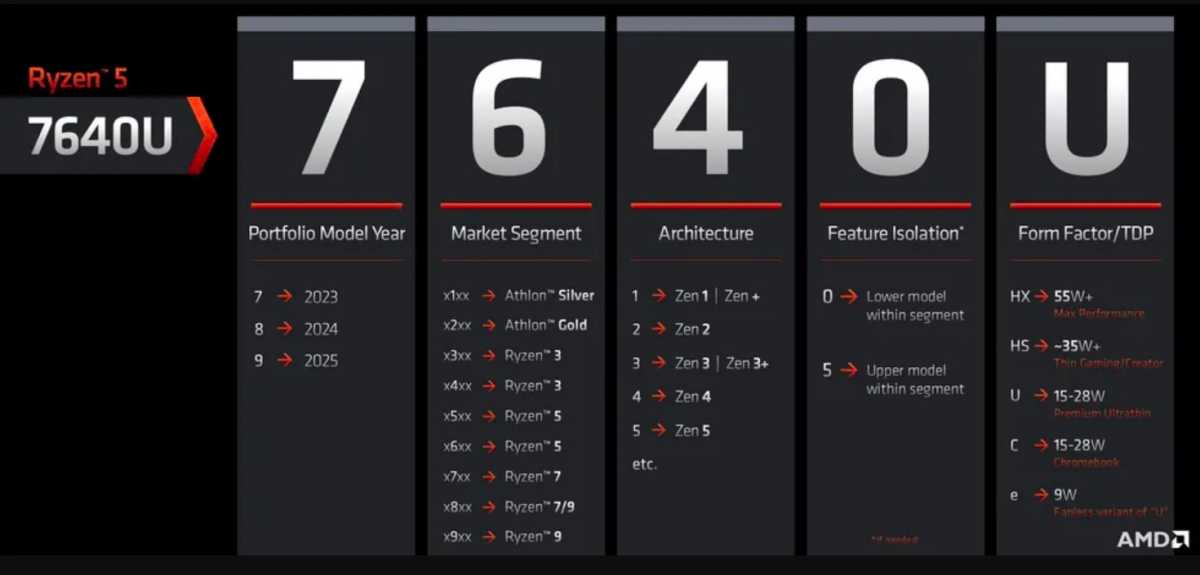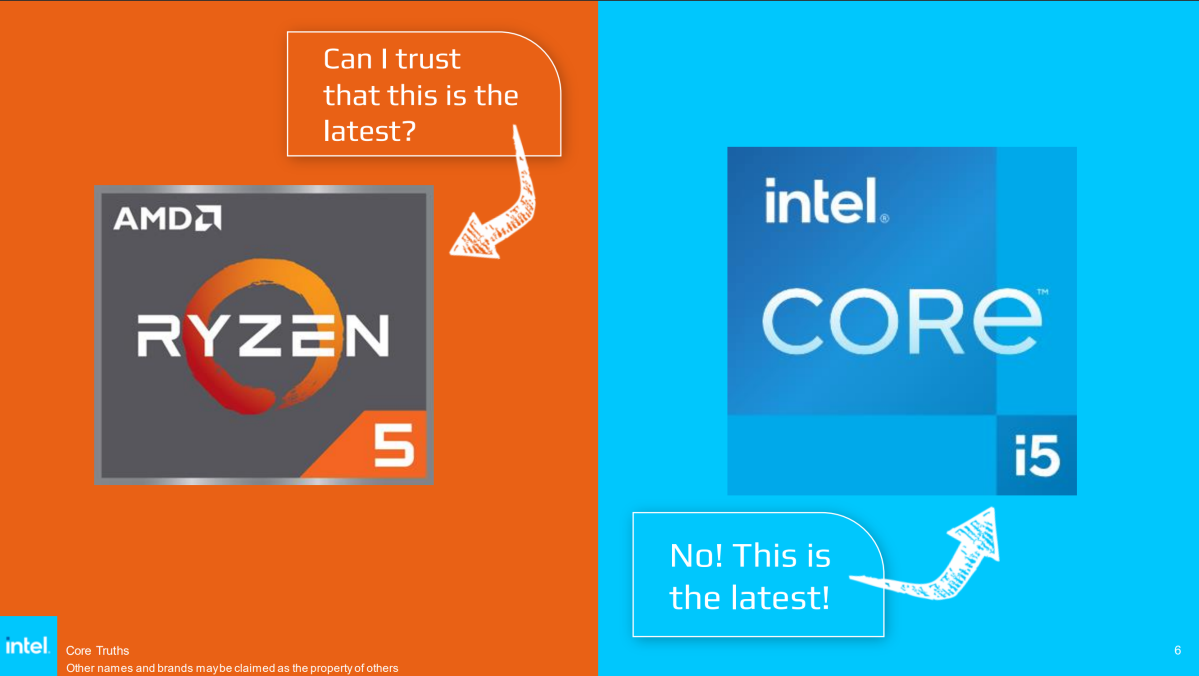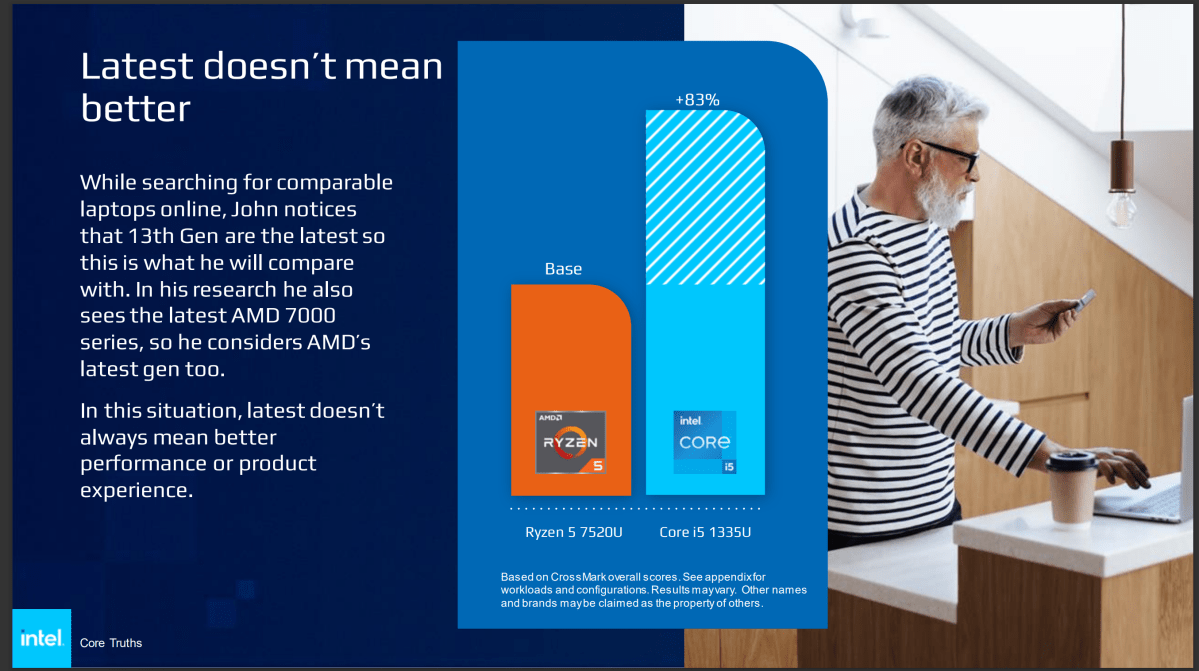 Image: Intel
Image: Intel
Intel has published a presentation that uses “snake oil” and used-car salesmen to imply that AMD is misleading customers with its recent Ryzen branding.
Unfortunately, the launch comes on the eve of major changes being made to Intel’s branding, too, as part of the launch of its “Core Ultra” Meteor Lake chips.
The PDF presentation, discovered by @momomo_us and Neowin, is titled “Core Truths — How the Latest Technology is not always what it seems”. “There’s a long history of selling half-truths to unsuspecting customers,” the presentation reads, next to a man holding a bottle that’s labeled “Snake Oil.”
The presentation then specifically goes on to call out AMD’s Ryzen branding, asking “Can I trust that this is the latest?” “No!” the presentation responds, with an arrow pointing to Intel’s own Core i5 branding.

Intel
Intel
Intel
Intel’s presentation refers back to AMD’s dizzying new Ryzen mobile processor naming scheme, which the company launched in September 2022. The branding uses four digits and a letter suffix to represent the model year, the market segment, the architecture, the “feature isolation,” and the form factor. AMD even supplied “decoder rings” to help journalists out, and as a fun piece of marketing material.
What Intel highlights is the third digit, specifically the architecture used. As the presentation notes, the Ryzen 5 7520U uses a dated Zen 2 architecture, originally developed in 2019. But AMD also markets the chip as part of the 7000-series family, which also infers that those chips use AMD’s latest technology. And many do: the Ryzen 7045 and 7040 series use AMD’s Zen 4 architecture.
Intel is correct in pointing out that the 7035 (Zen 3+), 7030 (Zen 3) and 7020 (Zen 2), all use older designs. Still, Intel’s site seems designed to provoke “FUD” (fear, uncertainty, and doubt) in customers considering buying AMD Ryzen-powered hardware.
“In a commercial buying scenario, it’s common for procurement teams to compare ‘equivalent’ options when filling out tender specs,” the presentation says. “For example, you might word the spec to include ‘latest gen Intel Core i5 or equivalent’. The Intel Core i5 and AMD 7000 Series are both ‘latest’ technologies but Core i5 1335U is up to 83% better in performance than Ryzen 5 7520U! In this example, the Ryzen 5 7520U would be far from equivalent!”
It’s worth noting that the Ryzen 5 7520U in a low-end processor intended for ultra-affordable notebooks, while Intel’s Core i5 targets more midrange laptops.

AMD
AMD
AMD
Ironically, AMD’s naming scheme was spearheaded by Robert Hallock, then director of technical marketing for AMD. Hallock subsequently left AMD for Intel, where he currently holds a similar title. It’s not clear whether Hallock was aware of or signed off on Intel’s presentation. The presentation seems intended for commercial and education customers, but could apply to consumers as well.
Also ironically, Intel is undergoing its own branding changes as Meteor Lake debuts — the 14th-gen Core chips. In June, Intel indicated that several changes were coming to its branding strategy: it will drop the “i” from its Core i-series chips, leaving the “Core i5” as just the “Core 5.” Higher-end Meteor Lake chips will now be referred to as the Core Ultra, possibly tweaking some of the own suffixes and high-end branding Intel has used in the past, such as the Core i9, HX series, and “KF” chips.

Intel
Intel
Intel
Intel has yet to announce its own lineup of Meteor Lake chips, though the company has gone into extensive detail describing how the Meteor Lake architecture differs from previous generations, including multiple processor tiles with differing capabilities, the addition of new low-power E-cores, and AI functionality. But leaked benchmark results have already revealed the Core Ultra 7 155H (six P-Cores, eight E-cores, and two low-voltage E-Cores), the Ultra 9 185H (6 P cores, 10 E cores) and possibly the Core Ultra 7 165H and Core Ultra 7 1002H as well. If the latter processor is real, it would use a different naming scheme — which Intel hasn’t described, anyway.
Also also ironically, Intel’s 14th-gen Core laptop and desktop processors use two totally different architectures built on two totally different processors — the radical new Meteor Lake hybrid architecture in laptops, and “Raptor Lake Refresh” in desktops.
Intel is scheduled to reveal its laptop processor details, its PC partners, and more at the December 14th launch of the Meteor Lake family, followed by laptop debuts at CES in January and subsequent shipping dates after that. But with such radical changes being made to Intel’s branding in just a week, should Intel really be throwing stones?

Intel
Intel
Intel
We’ll have to see. Neither Intel nor AMD responded to our requests for comment by press time.
Author: Mark Hachman, Senior Editor

As PCWorld’s senior editor, Mark focuses on Microsoft news and chip technology, among other beats. He has formerly written for PCMag, BYTE, Slashdot, eWEEK, and ReadWrite.
Recent stories by Mark Hachman:
No, Intel isn’t recommending baseline power profiles to fix crashing CPUsApple claims its M4 chip’s AI will obliterate PCs. Nah, not reallyIntel says manufacturing problems are hindering hot Core Ultra sales



